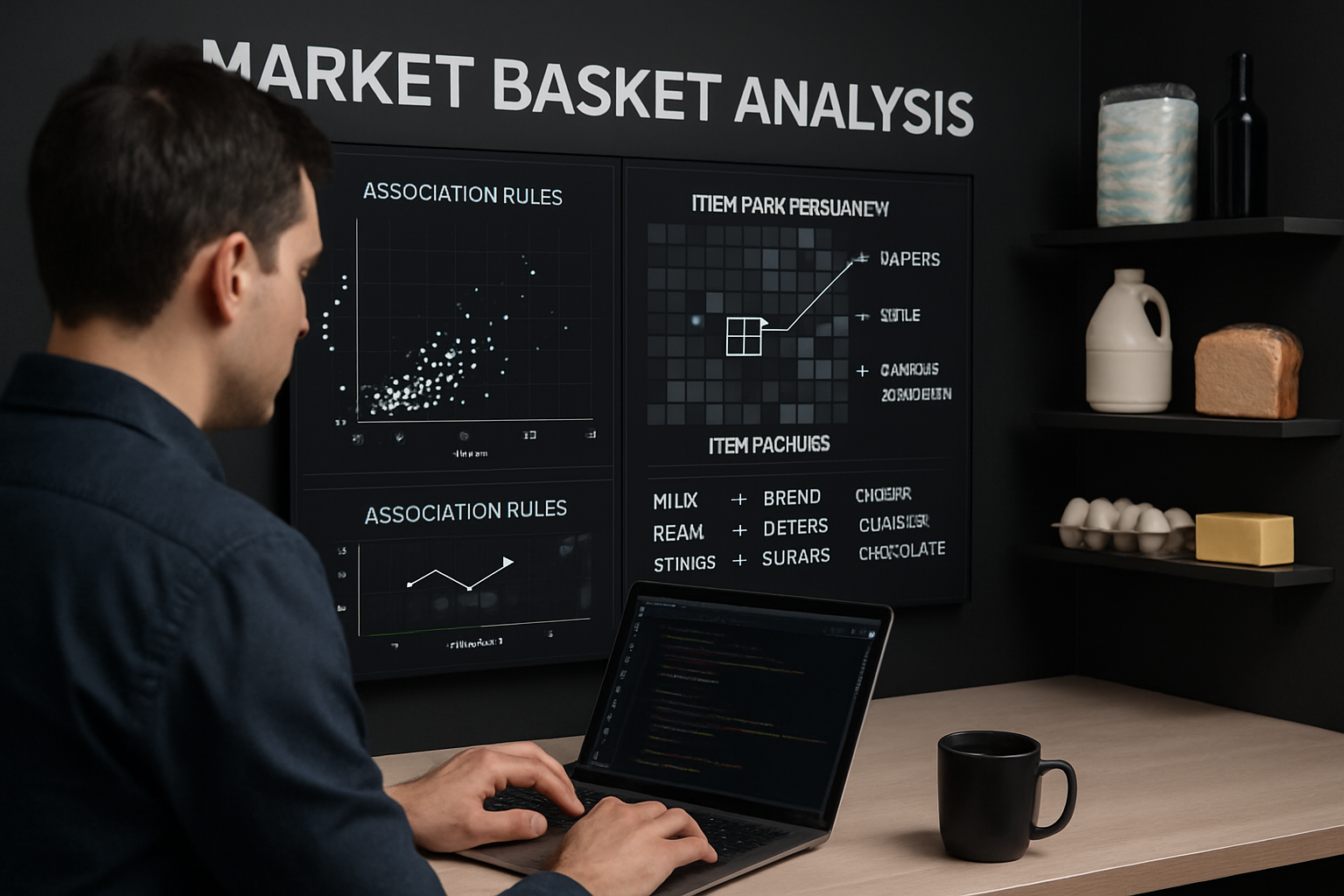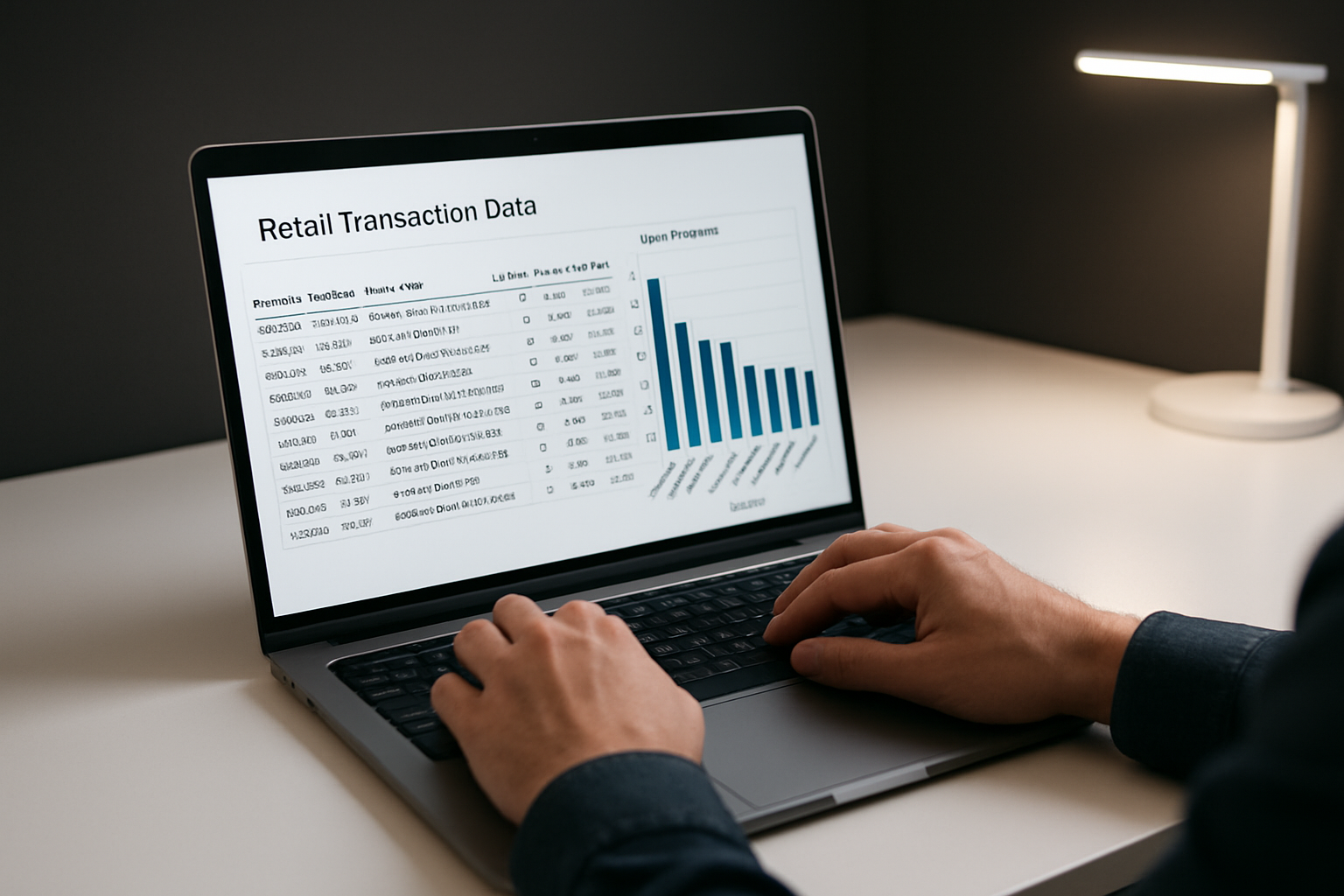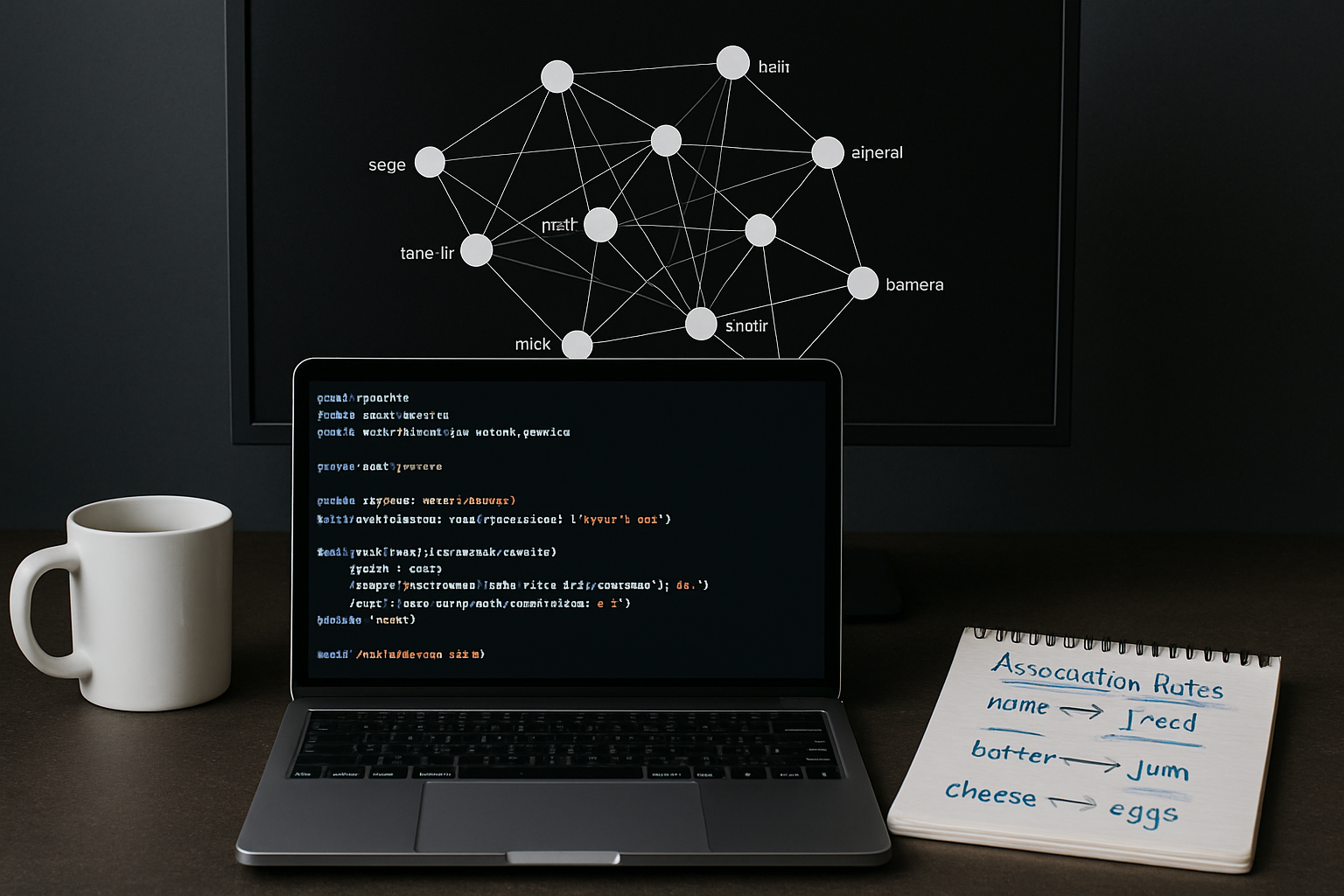Ever wondered how giants like Amazon seem to know exactly what you want to buy next? The secret lies in data-driven decision-making, which has exploded across retail and e-commerce in recent years.
Understanding customer buying patterns isn’t just a trend—it’s a competitive necessity. With the right tools, you can uncover hidden associations in your sales data and transform simple transactions into powerful business insights.
This guide is your roadmap to mastering market basket analysis python. We’ll walk you through every step, using real-world datasets and the latest tools for 2025.
You’ll learn the fundamentals, data requirements, Python setup, preprocessing, the Apriori algorithm, rule interpretation, and how to turn insights into actionable strategies.
Ready to boost your sales and stay ahead of the competition? Follow this step-by-step tutorial and unlock the full potential of your business data.
Understanding Market Basket Analysis: Concepts & Use Cases
Market basket analysis python is a powerful tool for uncovering patterns in transactional data. It helps retailers and e-commerce businesses understand which items are frequently purchased together. By analyzing these relationships, companies can make smarter decisions about product placement, bundling, and promotions. Let’s break down the core concepts and real-world impact of this essential analytics technique.

What Is Market Basket Analysis?
Market basket analysis python is a data mining approach used to discover associations between products in transactional datasets. The method identifies "if–then" relationships, known as association rules, revealing which items are likely to be bought together.
Key metrics drive this process:
- Support: How often a combination of items appears in all transactions.
- Confidence: The likelihood of purchasing item Y when item X is bought.
- Lift, leverage, conviction: These advanced metrics help evaluate rule strength.
Recommendation engines, such as those used by Amazon and Netflix, often rely on market basket analysis python. For example, a grocery store might find that chips and salsa are frequently bought together, prompting targeted promotions.
Core Use Cases in 2025
The versatility of market basket analysis python continues to expand in 2025. In e-commerce, it powers personalized product recommendations and effective cross-selling strategies. Brick-and-mortar retailers use MBA to optimize product placement and in-store promotions.
Inventory managers leverage the insights to forecast demand for bundled items, while marketers design targeted campaigns based on purchase patterns. For instance, a bookstore might pair biography and history sections together after discovering a strong association in sales data.
To see how MBA drives real business results, check out this guide on market basket analysis for ecommerce growth.
Key Metrics Explained with Examples
Market basket analysis python relies on several key metrics to evaluate association rules:
| Metric | What It Measures | Example |
|---|---|---|
| Support | Frequency of itemsets in all baskets | “Mineral water” in 23.8% of transactions |
| Confidence | Probability of buying Y given X | “Poppy’s Playhouse Bedroom” → “Kitchen”: 86% |
| Lift | Strength of association compared to random | Lift >1: strong link between items |
| Leverage | Difference from expected co-occurrence | Positive leverage means synergy |
| Conviction | Strength of implication | Higher conviction = stronger dependency |
A high lift (e.g., 65) between “Poppy’s Playhouse” items signals a strong opportunity for bundling, making these metrics essential for actionable market basket analysis python insights.
Challenges and Limitations
While market basket analysis python brings valuable insights, it comes with challenges. As the number of items grows, the number of possible rules increases rapidly. For instance, 122 items can generate over 14,500 rules, making it vital to prune weak or irrelevant ones.
Data quality is crucial—missing or noisy entries can skew results. Sometimes, high support pairs may have low confidence, which could mislead decision-making. Domain knowledge is needed to interpret the results correctly and turn them into business value.
Overcoming these hurdles ensures that market basket analysis python delivers meaningful, actionable results for your business.
Preparing Your Data for Market Basket Analysis in Python
Getting your data ready is the cornerstone of successful market basket analysis python workflows. Clean, well-structured data ensures your results are robust and actionable. Let’s walk through the essential steps, from sourcing transactional data to encoding it for the Apriori algorithm.

Data Requirements and Sources
To kick off market basket analysis python projects, you need transactional data in a structured format. The core requirement is a dataset with each transaction uniquely identified and a clear list of purchased items.
- Essential fields: Transaction ID, item names
- Optional fields: Price, date, customer ID, store location
- Popular datasets: UCI Online Retail II, Market_Basket.csv
Here’s a quick comparison table for reference:
| Field | Required | Purpose |
|---|---|---|
| Transaction ID | Yes | Groups items |
| Item | Yes | Identifies products |
| Price | No | Enables revenue analysis |
| Date | No | Time-based trends |
Always ensure your data respects privacy laws, especially when using real customer info. Larger datasets with thousands of transactions yield more meaningful insights for market basket analysis python.
Data Loading and Exploration
Once you have your dataset, load it into a pandas DataFrame for exploration. This step in market basket analysis python workflows is about understanding the structure and health of your data.
Start by using:
import pandas as pd
data = pd.read_csv('Market_Basket.csv')
print(data.info())
print(data.head())
Look for:
- Number of transactions and unique items
- Missing values or anomalies
- Item frequency distribution
Visualize popular items with a quick bar chart:
data['Item'].value_counts().head(40).plot(kind='bar')
Want hands-on guidance? Check out this Market Basket Analysis with Python example using real-world datasets.
Data Cleaning and Preprocessing
Data cleaning is a vital step in market basket analysis python. Remove nulls, standardize item names, and drop irrelevant records to create a reliable foundation.
Key cleaning tasks:
- Drop rows with missing Item or Transaction ID
- Strip whitespace and unify capitalization
- Remove duplicates
Example in pandas:
data = data.dropna(subset=['Item', 'TransactionID'])
data['Item'] = data['Item'].str.strip().str.lower()
data = data.drop_duplicates()
Decide on a threshold for rare items. Exclude products bought only once or twice, as they may not contribute to meaningful association rules in your market basket analysis python workflow.
Transaction List Creation
For market basket analysis python, you’ll need your data as a list of lists—each sublist representing items bought in a single transaction.
Steps:
- Group data by Transaction ID.
- Aggregate item names into lists.
- Remove any “nan” or empty entries.
Sample code:
transactions = data.groupby('TransactionID')['Item'].apply(list).tolist()
Preview a few transactions to ensure accuracy:
print(transactions[:3])
This format is essential for the next step in market basket analysis python: encoding your transactions for the Apriori algorithm.
One-Hot Encoding for Apriori
Before applying Apriori, transform your transaction list into a binary matrix using one-hot encoding—a critical step in market basket analysis python.
Use mlxtend’s TransactionEncoder:
from mlxtend.preprocessing import TransactionEncoder
te = TransactionEncoder()
te_ary = te.fit(transactions).transform(transactions)
df = pd.DataFrame(te_ary, columns=te.columns_)
Check your DataFrame:
- Each column is an item, each row is a transaction
- Values are True/False for item presence
- Drop any irrelevant columns like “nan”
Now your market basket analysis python dataset is ready for frequent itemset mining and rule generation.
Step-by-Step Market Basket Analysis in Python
Ready to demystify market basket analysis python workflows? This hands-on walkthrough will empower you to extract actionable insights from transactional data using Python. Follow each step closely, and you’ll be able to conduct your own analysis, visualize results, and uncover the patterns that drive smarter retail decisions.

Step 1: Installing Required Libraries
Before diving into market basket analysis python projects, make sure your environment is equipped with the right libraries. You’ll need:
pandasfor data manipulationmlxtendfor Apriori and association rulesnumpyfor numerical operationsmatplotlibandseabornfor visualization
Install them using pip:
!pip install mlxtend pandas matplotlib seaborn
After installation, import the essential modules:
import pandas as pd
import numpy as np
from mlxtend.preprocessing import TransactionEncoder
from mlxtend.frequent_patterns import apriori, association_rules
import matplotlib.pyplot as plt
import seaborn as sns
Ensure you’re running Python 3.10+ for compatibility. If you face installation errors, check for conflicting package versions or permissions. For a deeper dive into the algorithms behind this workflow, consult this Comprehensive Guide on Market Basket Analysis.
Step 2: Loading and Inspecting the Dataset
Start your market basket analysis python journey by loading your transactional dataset. Use read_csv or read_excel depending on your file type:
data = pd.read_csv('Market_Basket.csv')
Quickly inspect your data:
print(data.info())
print(data.head())
Check the number of transactions and unique items:
- Rows: Each transaction (e.g., 7,501)
- Columns: Item details (e.g., 'Invoice', 'Description')
To spot popular products, use:
print(data['Description'].value_counts().head(10))
Visualize the top-selling items with a barplot:
top_items = data['Description'].value_counts().head(40)
top_items.plot(kind='bar', figsize=(12, 6))
plt.title('Top 40 Items by Frequency')
plt.show()
Exploring your data upfront ensures the market basket analysis python process starts on solid ground.
Step 3: Data Cleaning and Transaction Preparation
High-quality input is crucial for reliable market basket analysis python results. Begin by dropping nulls and duplicates:
data.dropna(subset=['Invoice', 'Description'], inplace=True)
data.drop_duplicates(inplace=True)
Standardize item names for consistency:
data['Description'] = data['Description'].str.strip().str.lower()
Group items by transaction (invoice):
transactions = data.groupby('Invoice')['Description'].apply(list).values.tolist()
Consider filtering out rare items:
item_counts = pd.Series([item for sublist in transactions for item in sublist]).value_counts()
common_items = item_counts[item_counts > 5].index
transactions = [[item for item in basket if item in common_items] for basket in transactions]
Preview a few transactions to confirm everything looks right. Clean, grouped data is the backbone of successful market basket analysis python projects.
Step 4: One-Hot Encoding Transaction Data
Apriori and other algorithms require data in a binary format. For market basket analysis python tasks, use TransactionEncoder:
te = TransactionEncoder()
te_ary = te.fit(transactions).transform(transactions)
df = pd.DataFrame(te_ary, columns=te.columns_)
Drop any irrelevant or placeholder columns:
if 'nan' in df.columns:
df = df.drop('nan', axis=1)
Check the shape and a sample row:
print(df.shape)
print(df.head())
Now, each transaction is a row, and each item is a column marked True/False. Your market basket analysis python dataset is ready for the Apriori algorithm.
Step 5: Applying the Apriori Algorithm
With your data encoded, run the Apriori algorithm to find frequent itemsets:
frequent_itemsets = apriori(df, min_support=0.01, use_colnames=True)
Review the output:
print(frequent_itemsets.head())
Each row shows an itemset and its support (frequency). For example, if “10 colour spaceboy pen” appears in 1.14% of all transactions, its support is 0.0114. Adjust min_support to control the number of itemsets:
- Increase to focus on the most common combinations
- Decrease to include rarer, possibly more interesting associations
This step uncovers the foundational patterns for your market basket analysis python insights.
Step 6: Generating Association Rules
Now, generate association rules from your frequent itemsets:
rules = association_rules(frequent_itemsets, metric="lift", min_threshold=1)
Explore the resulting DataFrame:
print(rules[['antecedents', 'consequents', 'support', 'confidence', 'lift']].head())
Filter for strong rules:
strong_rules = rules[(rules['confidence'] > 0.7) & (rules['lift'] > 1)]
Export rules for further review:
strong_rules.to_csv('mba_rules.csv', index=False)
This process reveals actionable relationships for your market basket analysis python workflow.
Step 7: Visualizing and Exploring Results
Visualization turns numbers into insights. For market basket analysis python findings, start with bar charts:
top_items = df.sum().sort_values(ascending=False).head(15)
top_items.plot(kind='bar')
plt.title('Top 15 Items by Support')
plt.show()
For more advanced visuals, use network graphs to map item associations:
import networkx as nx
G = nx.from_pandas_edgelist(strong_rules, 'antecedents', 'consequents')
plt.figure(figsize=(10,8))
nx.draw(G, with_labels=True)
plt.show()
Visual patterns help identify clusters and cross-sell opportunities, making your market basket analysis python results business-ready.
Step 8: Pruning and Interpreting Rules
Not every rule is valuable. For effective market basket analysis python, prune rules with low support or confidence:
pruned_rules = strong_rules[
(strong_rules['support'] > 0.01) &
(strong_rules['confidence'] > 0.7)
]
Focus on high-lift, high-confidence rules that align with business goals. Document your findings clearly, highlighting actionable associations.
Summarize insights in a table:
| Antecedent | Consequent | Support | Confidence | Lift |
|---|---|---|---|---|
| poppy’s playhouse bedroom | poppy’s playhouse kitchen | 0.012 | 0.86 | 65.0 |
| blue spotty cup | pink spotty cup | 0.025 | 0.70 | 4.5 |
Clear interpretation and communication ensure your market basket analysis python efforts translate into business impact.
Interpreting Association Rules: Turning Data into Actionable Insights
When you run a market basket analysis python workflow, the output is a set of association rules. These rules describe how items in your dataset relate to each other, typically in the form of "antecedents ⇒ consequents." Each rule includes key columns: support, confidence, lift, leverage, and conviction. For example, the rule (POPPY’S PLAYHOUSE BEDROOM) ⇒ (POPPY’S PLAYHOUSE KITCHEN) might show 86% confidence and a lift of 65, signaling a very strong relationship. To prioritize, sort your rules by lift or confidence, focusing on those with the highest business impact. For a deeper dive into these metrics and their definitions, see Understanding top retail analytics terms. Mastering these outputs is essential for anyone applying market basket analysis python techniques.

Understanding Rule Outputs
Market basket analysis python tools generate rules that look like:antecedents ⇒ consequents
For each rule, you'll see key metrics:
| Metric | What It Means |
|---|---|
| Support | How often items appear together |
| Confidence | Likelihood of buying Y if X is bought |
| Lift | Strength of association vs. random pairing |
| Leverage | Difference from expected co-occurrence |
| Conviction | Strength of implication (higher = stronger) |
For instance, if you see a rule with 86% confidence and a lift of 65, that’s a strong signal. Prioritize rules with high lift or confidence, as these often highlight the best cross-sell or bundling opportunities in your market basket analysis python projects.
Practical Scenarios and Business Applications
How do you turn association rules into profit? Start by looking at the combinations:
- High support & high confidence: Perfect for bundling and cross-promotions.
- High support, low confidence: Popular items, but rarely bought together; promote separately.
- Low support, high confidence: Niche combos; target special segments.
- Low support, low confidence: Typically not actionable.
For example, if "Blue Spotty Cup" and "Pink Spotty Cup" are purchased together with 70% confidence, you might bundle them or create targeted offers. The market basket analysis python approach helps you spot these patterns fast, so you can act before competitors do.
Advanced Metrics: Leverage and Conviction
Beyond support, confidence, and lift, leverage and conviction provide deeper insights. Leverage measures the difference between observed and expected co-occurrence; positive values suggest synergy. Conviction assesses how strongly the presence of one item implies the other. Use these metrics to filter out rules that look strong but are actually misleading. For more on these advanced measures, check out Understanding top retail analytics terms. When using market basket analysis python, cross-verifying multiple metrics ensures your decisions are data-driven and robust.
Visualization Techniques for Rule Analysis
Visualization is key for making sense of your market basket analysis python results. Bar plots quickly highlight the most frequent itemsets or strongest rules. Network diagrams help you see clusters—groups of products often bought together. Heatmaps can show support or confidence matrices at a glance. For example, visualizing the co-occurrence of "Green Regency Teacup" and "Roses Regency Teacup" in a heatmap makes it clear where product pairings matter. These visuals not only simplify complex data but also help communicate findings to non-technical stakeholders.
From Insights to Implementation
Turning insights from market basket analysis python into action can transform your business. Use strong rules to inform product bundling, shelf placement, or targeted digital ads. You can even feed association rules into recommendation engines to boost average order value and inventory turnover. For a practical look at how MBA drives growth, see Increase average order value with MBA. One bookstore, for example, rearranged sections based on these insights and saw a measurable sales boost. Keep monitoring and iterating—market trends can shift quickly.
Common Pitfalls and Best Practices
Even with powerful market basket analysis python tools, pitfalls exist. Avoid overfitting by ignoring rules with very low support—they may not generalize. Regularly update your analysis with new data to keep recommendations relevant. Combine MBA with customer segmentation for richer insights and always ensure data privacy and compliance. Documenting your interpretations and actions helps your team stay aligned and builds a knowledge base for future analysis.
Advanced Topics and Trends in Market Basket Analysis for 2025
Staying ahead in retail and e-commerce means embracing the latest innovations in market basket analysis python. As transactional data grows in complexity and volume, advanced strategies are required to unlock deeper, more actionable insights. This section explores the leading-edge techniques, scalability concerns, integration with recommendation systems, and the ethical landscape shaping market basket analysis python in 2025.
Custom Metrics and Rule Aggregation
Beyond classic metrics like support and confidence, businesses are customizing rule evaluation to align with specific goals in market basket analysis python. Custom scoring functions, such as profitability-weighted lift or customer lifetime value integration, are gaining traction. Aggregating rules for multi-item antecedents or consequents helps reduce noise and highlights more meaningful patterns.
A sample comparison table:
| Metric | Purpose | When to Use |
|---|---|---|
| Profit Lift | Profit-focused bundling | Margin optimization |
| Frequency Index | Detect rare, valuable combos | Niche targeting |
For a deeper dive into these advanced strategies, see Advanced market basket analysis strategies. With smart aggregation and tailored metrics, market basket analysis python provides insights that fuel data-driven growth.
Scalability and Performance Optimization
As datasets scale to millions of transactions, market basket analysis python must be both fast and efficient. Memory optimization is key—consider chunk processing, sparse matrices, and parallel computation. Python libraries like Dask or cloud-based platforms can distribute workloads, reducing analysis time from hours to minutes.
Quick tips for scalable analysis:
- Batch process large files
- Use efficient data formats (e.g., Parquet)
- Leverage GPU acceleration where possible
Monitoring resource usage ensures market basket analysis python remains responsive as your business grows. Performance tuning guarantees insights are delivered without bottlenecks or delays.
Integrating MBA with Recommendation Systems
Modern recommendation engines often blend market basket analysis python with AI-driven approaches. Association rules can be used alongside collaborative filtering to suggest product pairings in real-time, enhancing the customer experience. This hybrid approach leverages both transaction data and user behavior for precise recommendations.
For example, after identifying strong item associations with market basket analysis python, you can feed these rules into a recommender system to drive cross-sells on your e-commerce site. Combining algorithms allows you to adapt to changing shopping patterns and deliver more relevant suggestions.
Future Trends and Ethical Considerations
In 2025, automated, AI-powered tools are transforming market basket analysis python. Privacy-preserving analytics and data anonymization are now standard, as regulatory requirements tighten. Explainable AI is on the rise, ensuring business decisions based on association rules are transparent and justifiable.
Emerging trends include:
- Integration with IoT for omnichannel insights
- Real-time MBA dashboards
- Ethical frameworks for responsible data use
As you adopt these innovations, remember that the future of market basket analysis python is as much about trust and responsibility as it is about technology.